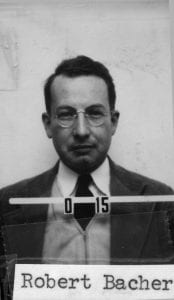Robert Bacher (1905-2004)

Background
Bacher was a nuclear physicist known for his leadership at the Los Alamos laboratory during the Manhattan Project. He received his bachelor’s and PhD degree in physics at the University of Michigan. After graduation, he held teaching positions at Columbia University, and later Cornell University, advancing from assistant professor to tenured professor in 1945. At Cornell, Bacher measured neutron absorption with a neutron velocity spectrometer, which was also used for experiments at Los Alamos. He also worked on radar research at MIT’s Radiation Laboratory. During this time, he was contacted by Robert Oppenheimer due to his work connected with the Radiation Lab. Oppenheimer was “was very much interested in the problems that one would run into in setting up a new laboratory. This was why he came to us.”
Manhattan Project
Robert Bacher headed the experimental physics division of the Los Alamos Laboratory during the war. As a partner with Oppenheimer in setting up the new Los Alamos lab, he “felt very strongly that a laboratory could not be a military laboratory”, because doing so would go against the ideals of scientific research and thus established it as a civilian laboratory. He started as a leader in the physics division. In 1944, Bacher lead the G, or “gadget” division of the lab, which came up with the design of the implosion-type ‘Fat Man’ atomic bomb. In the transition from a uranium bomb to developing a plutonium bomb, Bacher’s division experimented with the symmetry of implosion to compress the plutonium center. He was also one of the scientists that participated in the 1945 Trinity test of the bomb’s plutonium core.
After the war and the AEC
Post-war, Bacher remained involved in policy as a United Nations technical advisor to Bernard Baruch. He also joined as a member of the Atomic Energy Commision as it’s only scientist. In an interview he stated, “I felt that for the Atomic Energy Commission to start up without having scientific representation on it was not the right thing to do,” especially at the highest level of policy-making. During the first half of his time on the board, Bacher conducted investigations at the Los Alamos and Hanford nuclear facilities and discovered they were not producing bombs at the rate the US government had hoped for their nuclear stockpile. Under his guidance, the labs were able to resume weapon production to a suitable level. In the later half of his time at the AEC, Bacher was able to propose alternative, non-weaponized uses of nuclear power. After his time on the Atomic Energy Commision, he returned to Caltech as faculty and head of the Physics, Math and Astronomy division, where he remained until retirement.
Written by Sabrina Tsui
Sources:
Interview of Robert Bacher by Finn Aaserud on 1986 February 13, Niels Bohr Library & Archives, American Institute of Physics, College Park, MD USA.
Robert Bacher Biography. Engineering and Technology History Wiki.
Sherwin, Martin J. “Robert Bacher’s Interview – Part 1.” Robert Bacher’s Interview – Part 1, Manhattan Project Voices, 29 Mar. 1983.
Ward Whaling. Robert F. Bacher A biographical Memoir. National Academy of Sciences, 2009.

